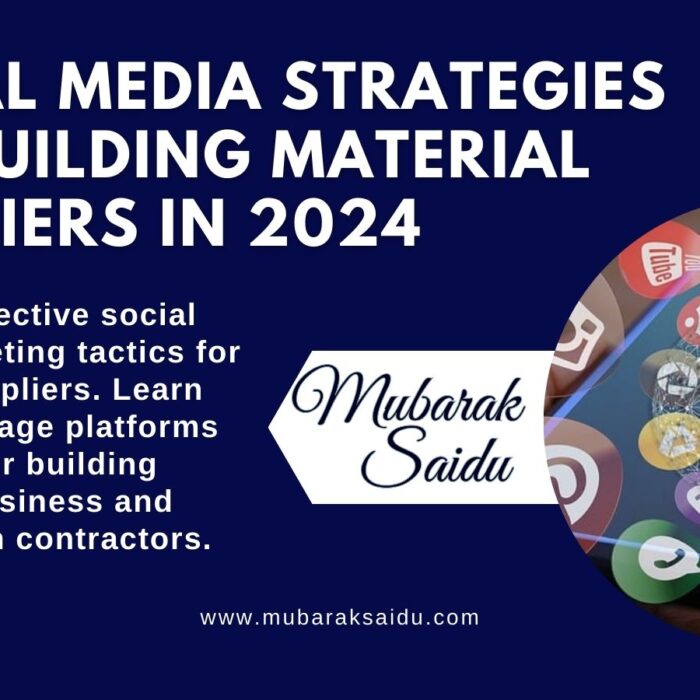
Are you struggling to nail down the right social media strategy for your building materials business? You’re not alone! A whopping 97% of construction companies use social media, but only 45% feel they’re using it effectively.
It’s time to change that! In this guide, we’ll explore the top social media platforms that can help you showcase your products, connect with contractors, and build a strong online presence.
Let’s dive in and construct a solid foundation for your digital marketing efforts!
LinkedIn: The Professional’s Choice for Building Materials Marketing

LinkedIn has emerged as the go-to platform for B2B marketing in the construction and building materials industry. With over 830 million members worldwide, it’s a goldmine for connecting with decision-makers, architects, and contractors.
Let’s dive into how you can leverage this powerhouse for your building materials business:
Optimizing Your Company Page
- Create a compelling “About” section that clearly articulates your unique value proposition
- Use high-quality images and videos showcasing your products in action
- Regularly update your page with industry news, product launches, and company milestones
- Utilize LinkedIn’s showcase pages to highlight specific product lines or services
Pro tip: Use relevant keywords like “sustainable building materials” or “innovative construction products” in your company description to improve searchability.
Content Strategy for Engagement
- Share a mix of educational content, product information, and industry insights
- Create long-form articles using LinkedIn’s publishing platform to establish thought leadership
- Post regular updates about your products, including case studies and success stories
- Use rich media like infographics and videos to boost engagement
Remember, consistency is key! Aim to post at least 2-3 times per week to maintain visibility in your followers’ feeds.
Building a Strong Network
- Connect with industry professionals, including contractors, architects, and procurement managers
- Engage with posts from industry leaders and potential clients by commenting and sharing insights
- Encourage your employees to become brand ambassadors by sharing company content
- Use LinkedIn’s advanced search features to find and connect with decision-makers in your target companies
Leveraging LinkedIn Groups
- Join relevant groups in the construction and building materials sector
- Participate in discussions by offering valuable insights and advice (without being overly promotional)
- Share your content when it’s genuinely helpful to the group members
- Consider creating your own LinkedIn Group focused on a niche within the building materials industry
Advertising on LinkedIn
- Utilize Sponsored Content to boost your best-performing posts and reach a wider audience
- Create targeted InMail campaigns to reach decision-makers directly
- Use LinkedIn’s detailed targeting options to narrow down your audience by job title, company size, and industry
- Experiment with LinkedIn’s Dynamic Ads for personalized, eye-catching advertisements
Measuring Success and ROI
- Track key metrics such as engagement rate, click-through rate, and lead generation
- Use LinkedIn’s built-in analytics tools to understand your audience and content performance
- Monitor your Sales Navigator usage to see how it impacts your lead-generation efforts
- Calculate the cost per lead and compare it to other marketing channels
By implementing these strategies, you’ll be well on your way to establishing a strong presence on LinkedIn and generating valuable leads for your building materials business.
Remember, success on LinkedIn doesn’t happen overnight – it requires consistent effort and a willingness to adapt your strategy based on performance data.
Instagram: Visualizing Your Products in the Construction World

In today’s visually-driven market, Instagram has become a powerhouse for showcasing building materials and construction products. With over 1 billion active users, this platform offers a unique opportunity to bring your products to life and inspire potential clients.
Let’s dive into how you can leverage Instagram to boost your building materials brand and engage with your target audience.
Crafting a Visually Stunning Feed
Your Instagram feed is your digital showroom. Make it count!
- Showcase your products in real-world applications, highlighting innovative construction techniques and sustainable building practices.
- Use high-quality images and videos that demonstrate the durability and versatility of your materials.
- Create a cohesive aesthetic by using consistent filters or editing styles that align with your brand identity.
- Incorporate before-and-after shots to illustrate the transformative power of your products in construction projects.
Pro tip: Use a mix of professional photography and authentic, behind-the-scenes content to give followers a well-rounded view of your brand and products.
Leveraging Instagram Stories and Reels
Stories and Reels offer dynamic ways to engage your audience and showcase your building materials in action.
- Use Stories to provide quick tips, product demonstrations, or sneak peeks of upcoming launches.
- Create educational Reels that highlight proper installation techniques or innovative uses for your materials.
- Share customer testimonials or mini-case studies through video content.
- Utilize Instagram’s interactive features like polls or questions to gather feedback and engage with your audience.
Remember, authenticity is key! Don’t be afraid to show the human side of your brand through employee spotlights or day-in-the-life content.
Mastering the Art of Hashtags
Hashtags are your ticket to discoverability in the vast Instagram landscape.
- Research and use industry-specific hashtags like #BuildingMaterials, #ConstructionProducts, or #SustainableConstruction.
- Create branded hashtags for your company and encourage customers to use them when showcasing their projects.
- Participate in trending hashtags relevant to the construction industry to increase visibility.
- Use location-based hashtags to target specific markets or regions.
Aim for a mix of popular and niche hashtags to maximize your reach while staying relevant to your target audience.
Collaborating with Influencers and Industry Experts
Influencer partnerships can significantly amplify your reach and credibility.
- Identify and collaborate with construction influencers, architects, or DIY experts who align with your brand values.
- Invite influencers for product demonstrations or to tour your manufacturing facilities.
- Sponsor content that showcases your products being used in real projects.
- Engage in Instagram takeovers with industry experts to provide valuable insights to your followers.
Utilizing Instagram Shopping Features
Turn your Instagram into a virtual catalog for your building materials.
- Set up Instagram Shopping to tag products directly in your posts and stories.
- Create shoppable posts that allow users to learn more about your products without leaving the app.
- Use the “Swipe Up” feature in Stories (if available) to link directly to product pages or case studies.
- Showcase new product launches through dedicated shopping posts and stories.
Engaging with Your Community
Build a thriving community around your brand on Instagram.
- Respond promptly to comments and direct messages to foster positive relationships.
- Feature user-generated content from contractors and DIY enthusiasts using your products.
- Host Instagram Live sessions for Q&As, product launches, or to discuss industry trends.
- Create and promote branded hashtags to encourage customers to share their projects.
Analyzing Performance and Refining Strategy
Use data to improve your Instagram strategy continually.
- Track key metrics like engagement rate, follower growth, and story views using Instagram Insights.
- Monitor which types of content perform best and adjust your strategy accordingly.
- Use A/B testing for different post types, captions, or posting times to optimize performance.
- Set specific, measurable goals for your Instagram presence and regularly assess your progress.
By implementing these strategies, you’ll be well on your way to creating a compelling Instagram presence that not only showcases your building materials but also builds a community around your brand.
Remember, success on Instagram is about more than just pretty pictures – it’s about telling your brand’s story, providing value to your audience, and consistently engaging with your community.
With persistence and creativity, you’ll soon see your Instagram efforts paying off in increased brand awareness and, ultimately, more sales for your building materials business.
Facebook: Building Community and Awareness in the Construction World

With over 2.9 billion monthly active users, Facebook remains a powerhouse for digital marketing in the building materials sector.
This platform offers unique opportunities to build brand awareness, engage with your target audience, and create a thriving community around your products.
Let’s explore how to leverage Facebook effectively for your construction-related business.
Crafting a Compelling Business Page
Your Facebook Business Page is the cornerstone of your presence on the platform.
- Optimize your “About” section with key information about your building materials company, including your specialties and unique selling propositions.
- Use high-quality images for your profile and cover photos that showcase your products or completed projects.
- Enable and customize relevant call-to-action buttons like “Shop Now” or “Contact Us” to drive conversions.
- Utilize the “Services” section to highlight your product categories or specialized offerings.
Pro tip: Ensure your page is verified to boost credibility and improve searchability within Facebook.
H3: Creating Engaging Content
Content is king on Facebook, and variety is the spice of engagement!
- Share a mix of educational posts, product highlights, industry news, and behind-the-scenes content.
- Use eye-catching visuals, including infographics about sustainable construction practices or energy-efficient materials.
- Create short, informative videos demonstrating product applications or installation techniques.
- Leverage Facebook Live to host Q&A sessions, product launches, or virtual tours of your manufacturing facilities.
- Share customer success stories and project showcases to build social proof.
Remember, the Facebook algorithm favors content that sparks conversations, so encourage comments and interactions with your posts.
Harnessing the Power of Facebook Groups
Facebook Groups can be a goldmine for building a community around your brand.
- Create a dedicated group for contractors, architects, and DIY enthusiasts interested in your products.
- Share exclusive content, tips, and early access to new products with group members.
- Encourage members to share their projects and experiences with your materials.
- Host regular “Ask Me Anything” sessions with your product experts or invited industry professionals.
- Use the group to gather feedback on new product ideas or improvements.
Leveraging Facebook Ads for Targeted Reach
Facebook’s advertising platform offers powerful targeting options for the construction industry.
- Create custom audiences based on website visitors, email lists, or engagement with your page.
- Use lookalike audiences to reach new potential customers similar to your existing client base.
- Experiment with different ad formats like carousel ads to showcase multiple products or video ads for demonstrations.
- Utilize retargeting to re-engage users who have shown interest in your products but haven’t made a purchase.
- Run locally targeted ads to support specific distributors or reach contractors in particular regions.
Fostering Customer Relationships
Use Facebook as a tool to build and maintain strong customer relationships.
- Respond promptly to comments and messages, aiming for a response time under 24 hours.
- Use Facebook Messenger to provide quick customer support and answer product queries.
- Implement a chatbot to handle common questions and guide users to relevant resources.
- Encourage and respond to reviews on your Facebook page to build trust and credibility.
Hosting Virtual Events and Webinars
Leverage Facebook’s event features to engage your audience and provide value.
- Host virtual product demonstrations or workshops on new construction techniques.
- Organize webinars featuring industry experts discussing trends in sustainable building or innovative materials.
- Create events for product launches or special promotions.
- Use Facebook Live within your events to increase engagement and interaction.
Measuring Success and Optimizing Performance
Utilize Facebook Insights to continually refine your strategy.
- Monitor key metrics like reach, engagement rate, and click-through rates on your posts and ads.
- Track the performance of different content types to understand what resonates with your audience.
- Use A/B testing for ad creatives and copy to optimize your campaigns.
- Set up conversion tracking to measure the impact of your Facebook efforts on actual sales or leads.
By implementing these strategies, you’ll be well-positioned to build a strong, engaged community around your building materials brand on Facebook.
Remember, success on this platform comes from consistently providing value, fostering genuine connections, and adapting to the evolving needs of your audience.
With patience and persistence, Facebook can become a powerful tool for growing awareness, generating leads, and ultimately driving sales for your construction products.
Pinterest: Inspiring Home Improvement Projects with Your Building Materials

Pinterest is a visual discovery engine that’s tailor-made for the building materials and home improvement sector.
With over 450 million active users, many of whom are actively seeking inspiration for their next renovation or DIY project, Pinterest offers a unique opportunity to showcase your products in action and drive traffic to your website.
Let’s explore how to leverage this platform to its full potential.
Crafting an Eye-Catching Profile
Your Pinterest profile is your virtual showroom, so make it count!
- Choose a username that reflects your brand and is easy to remember.
- Write a compelling bio that highlights your expertise in construction products and sustainable building solutions.
- Include keywords like “eco-friendly building materials” or “innovative home improvement products” to improve searchability.
- Add your website link and verify your account to boost credibility.
Pro tip: Use a high-quality logo or brand image as your profile picture to ensure instant recognition.
Creating Boards That Inspire and Convert
Organize your pins into themed boards that appeal to your target audience.
- Develop boards for different room types (e.g., “Kitchen Renovations,” “Bathroom Makeovers”) featuring your products.
- Create boards focused on specific materials or product lines you offer.
- Curate inspiration boards showcasing finished projects that incorporate your building materials.
- Don’t forget seasonal boards like “Summer Home Upgrades” or “Winter Weatherproofing” to stay relevant year-round.
Remember to use clear, descriptive board names and add relevant keywords to board descriptions for better SEO.
Pinning Strategies for Maximum Impact
Your pins are the heart of your Pinterest strategy. Make them count!
- Create high-quality, vertical images (2:3 aspect ratio) that stand out in Pinterest’s feed.
- Use text overlays on images to provide context or highlight key features of your products.
- Craft detailed, keyword-rich descriptions for each pin, including relevant hashtags.
- Implement Rich Pins to automatically include real-time pricing, availability, and product details.
- Mix product pins with lifestyle images showing your materials in beautiful, finished spaces.
Pro tip: Create multi-image pins or infographics to showcase before-and-after transformations or step-by-step DIY guides using your products.
Leveraging Video Pins for Engagement
Video content is increasingly popular on Pinterest, offering new ways to showcase your products.
- Create short, eye-catching video pins demonstrating product installation or usage.
- Develop time-lapse videos of renovation projects featuring your materials.
- Share quick tips or hacks related to home improvement and your products.
- Use Idea Pins (Pinterest’s multi-page video format) to create mini-tutorials or product showcases.
Remember to add captions to your videos, as many users watch without sound.
Collaborating with Influencers and Professionals
Partnerships can significantly extend your reach on Pinterest.
- Collaborate with home improvement bloggers or DIY influencers to create boards featuring your products.
- Invite architects or interior designers to curate guest boards showcasing innovative uses of your materials.
- Participate in group boards related to sustainable building or home renovation to increase visibility.
- Consider sponsoring pins created by trusted influencers in the construction and design space.
Optimizing for Pinterest SEO
Make your content discoverable with smart SEO practices.
- Conduct keyword research to understand what your target audience is searching for on Pinterest.
- Use these keywords naturally in your pin titles, descriptions, and board names.
- Create content around trending topics in home improvement and sustainable construction.
- Use relevant hashtags, but don’t overdo it – 2-3 per pin is usually sufficient.
Driving Traffic and Conversions
Turn Pinterest inspiration into real-world sales.
- Ensure all product pins link directly to the relevant page on your website.
- Create landing pages specifically for Pinterest traffic, tailored to the interests of this audience.
- Use Pinterest Tag to track conversions and retarget website visitors on Pinterest.
- Experiment with Promoted Pins to boost the visibility of your best-performing content.
Analyzing Performance and Refining Strategy
Use data to continually improve your Pinterest presence.
- Regularly review your Pinterest Analytics to understand which pins and boards are performing best.
- Track metrics like impressions, saves, click-throughs, and conversions.
- A/B test different pin designs, descriptions, and board layouts to optimize performance.
- Stay updated on Pinterest trends and algorithm changes to adapt your strategy accordingly.
By implementing these strategies, you’ll be well on your way to creating a compelling Pinterest presence that not only showcases your building materials but also inspires home improvement enthusiasts and professionals alike.
Remember, success on Pinterest is about providing value through visually appealing and informative content.
With consistency and creativity, you’ll soon see your efforts translating into increased brand awareness, website traffic, and ultimately, more sales for your building materials business.
Twitter: Real-Time Industry Updates for Building Materials Professionals

Twitter’s fast-paced, real-time nature makes it an ideal platform for staying on top of construction industry trends and connecting with key players in the building materials world.
With over 330 million monthly active users, Twitter offers a unique opportunity to engage in industry conversations, share timely updates, and establish your brand as a thought leader in the construction sector.
Crafting a Compelling Twitter Profile
Your Twitter profile is often the first impression potential followers will have of your brand.
- Choose a username that clearly represents your company and is easy to remember.
- Write a concise, keyword-rich bio that highlights your expertise in sustainable construction materials and innovative building solutions.
- Use a high-quality profile picture (typically your logo) and a header image that showcases your products or completed projects.
- Pin a tweet that introduces your brand or highlights your most important current offering or campaign.
Pro tip: Include relevant hashtags like #BuildingMaterials or #ConstructionInnovation in your bio to improve discoverability.
Sharing Valuable Content
On Twitter, content is king, but brevity is queen.
- Share industry news, market trends, and regulatory updates relevant to the construction sector.
- Post quick tips on sustainable building practices or energy-efficient material usage.
- Use threading to break down complex topics into easily digestible chunks of information.
- Share links to your blog posts, whitepapers, or case studies, providing a brief teaser in the tweet.
- Utilize Twitter’s poll feature to engage your audience and gather insights on industry preferences.
Remember to use a mix of text, images, GIFs, and videos to keep your content diverse and engaging.
Leveraging Hashtags Effectively
Hashtags are crucial for expanding your reach on Twitter.
- Use industry-specific hashtags like #ConstructionTech, #GreenBuilding, or #ArchitectureDesign.
- Create and promote branded hashtags for your company or specific product lines.
- Participate in relevant trending hashtags to join larger conversations.
- Use event-specific hashtags when attending or sponsoring industry conferences.
Pro tip: Don’t overdo it – 1-2 hashtags per tweet is often sufficient and more effective than hashtag stuffing.
Engaging in Real-Time Conversations
Twitter’s real-time nature allows for immediate engagement with your audience.
- Respond promptly to mentions, replies, and direct messages.
- Join or host Twitter chats related to construction industry topics.
- Live-tweet from industry events, sharing key takeaways and insights.
- Comment on and retweet posts from industry influencers, adding your own insights.
Utilizing Twitter Lists
Twitter Lists help you organize and monitor specific groups within the industry.
- Create lists for architects, contractors, sustainable building advocates, and industry news sources.
- Use these lists to curate content and stay informed about specific sectors of the industry.
- Share your public lists as a resource for others in the construction community.
Leveraging Twitter Ads
Twitter’s advertising platform can help amplify your message.
- Use Promoted Tweets to boost visibility of your best-performing content.
- Leverage Twitter’s targeting options to reach decision-makers in the construction industry.
- Experiment with Website Cards to drive traffic to specific product pages or resources.
- Use Twitter Ads to promote webinars, product launches, or special offers.
Showcasing Your Expertise
Position your brand as a thought leader in the building materials industry.
- Share insights on emerging trends like prefab construction or smart building materials.
- Offer expert commentary on industry news and regulatory changes.
- Host Q&A sessions or “Ask Me Anything” events on Twitter.
- Share behind-the-scenes content from your R&D department or manufacturing facilities.
Measuring Success and Optimizing Performance
Use Twitter Analytics to refine your strategy continually.
- Monitor key metrics like engagement rate, link clicks, and follower growth.
- Track which types of content and topics resonate most with your audience.
- Use A/B testing for different tweet formats, posting times, or ad creatives.
- Set specific, measurable goals for your Twitter presence and regularly assess your progress.
By implementing these strategies, you’ll be well-positioned to leverage Twitter as a powerful tool for real-time industry updates, engagement, and brand building in the construction materials sector.
Remember, success on Twitter comes from consistently providing value, engaging in meaningful conversations, and staying on top of industry trends.
With persistence and a strategic approach, you’ll soon see your Twitter efforts translating into increased brand awareness, valuable industry connections, and ultimately, more opportunities for your building materials business.
Houzz: Connecting with Home Improvement Enthusiasts and Design Professionals
Houzz has become a go-to platform for homeowners, architects, and contractors seeking inspiration and resources for renovation projects.
With over 65 million homeowners and 2.7 million home improvement professionals using the platform, Houzz offers a unique opportunity for building material companies to showcase products, connect with potential customers, and establish themselves as industry leaders.
Creating a Compelling Houzz Profile
Your Houzz profile is your digital storefront in the world of home improvement.
- Choose a username that clearly represents your building materials brand.
- Write a comprehensive “About Us” section highlighting your expertise in sustainable construction materials and innovative building solutions.
- Upload high-quality photos of your products, emphasizing their application in real-world settings.
- Include key information such as your website, contact details, and areas served.
- List your products and services, using relevant keywords to improve searchability.
Pro tip: Encourage satisfied customers and partners to leave reviews on your Houzz profile to build credibility.
Showcasing Your Products in the Houzz Marketplace
The Houzz Marketplace is a powerful tool for getting your building materials in front of potential buyers.
- Create detailed product listings with high-quality images, accurate descriptions, and pricing information.
- Use relevant keywords in your product titles and descriptions to improve visibility in Houzz search results.
- Categorize your products correctly to ensure they appear in relevant browsing sections.
- Highlight any eco-friendly or energy-efficient aspects of your materials to appeal to sustainability-conscious consumers.
- Regularly update your product catalog to reflect new offerings or seasonal promotions.
Leveraging Houzz Ideabooks
Ideabooks are a core feature of Houzz, allowing users to save and organize inspiration for their projects.
- Create your idea books showcasing how your building materials can be used in various design styles.
- Collaborate with architects and designers to feature your products in their idea books.
- Comment on and engage with user-created idea books that include your products.
- Use idea books to demonstrate before-and-after transformations using your materials.
Remember to use descriptive captions and tags in your Ideabook photos to improve discoverability.
Publishing Engaging Content
Houzz’s content platform allows you to share your expertise and showcase your products.
- Write articles about trends in sustainable building materials or innovative construction techniques.
- Create how-to guides for DIY projects using your products.
- Share case studies of successful projects featuring your building materials.
- Offer expert advice on topics like choosing the right materials for specific climate conditions or design styles.
- Use high-quality images and infographics to make your content visually appealing.
Engaging with the Houzz Community
Active participation in the Houzz community can significantly boost your visibility and credibility.
- Answer questions in the Houzz Advice section related to your area of expertise.
- Participate in Houzz discussions, offering valuable insights and subtle product recommendations where appropriate.
- Engage with comments on your projects and articles, fostering a sense of community around your brand.
- Collaborate with other professionals on the platform, such as architects or contractors, to cross-promote services.
Utilizing Houzz’s Professional Directory
Ensure your company is easily discoverable by potential clients and partners.
- Optimize your listing in the Houzz professional directory with relevant keywords and a comprehensive description of your services.
- Showcase your best projects and products in your portfolio.
- Encourage satisfied customers to leave reviews and ratings on your directory listing.
- Consider upgrading to a Houzz Pro+ account for enhanced visibility and lead generation features.
Leveraging Houzz Advertising Options
Houzz offers various advertising options to boost your visibility on the platform.
- Use Houzz display ads to target homeowners actively planning renovation projects.
- Experiment with sponsored products to promote specific building materials in relevant categories.
- Consider local advertising options to target homeowners and professionals in specific geographic areas.
- Use retargeting ads to re-engage users who have shown interest in your products or content.
Analyzing Performance and Refining Strategy
Use Houzz’s analytics tools to continually improve your presence on the platform.
- Monitor key metrics like profile views, product clicks, and engagement with your content.
- Track which products and project photos generate the most interest from users.
- Analyze the performance of your articles and idea books to understand what topics resonate with your audience.
- Use these insights to refine your content strategy and product offerings.
By implementing these strategies, you’ll be well-positioned to leverage Houzz as a powerful platform for connecting with home improvement enthusiasts, design professionals, and potential customers.
Remember, success on Houzz comes from consistently providing value through high-quality products, insightful content, and active community engagement.
With persistence and a strategic approach, you’ll soon see your Houzz efforts translating into increased brand awareness, valuable industry connections, and ultimately, more sales for your building materials business.
TikTok: Tapping into Trends and DIY Culture for Building Materials

TikTok has exploded in popularity, becoming a powerhouse for short-form video content and viral trends.
With over 1 billion active users worldwide, it offers a unique opportunity for building material companies to showcase their products, connect with a younger audience, and tap into the thriving DIY and home improvement culture.
Let’s explore how to leverage TikTok effectively for your construction-related business.
Crafting an Engaging TikTok Profile
Your TikTok profile is the first impression users will have of your brand.
- Choose a username that clearly represents your building materials company.
- Write a concise, catchy bio that highlights your expertise in innovative construction products and sustainable building solutions.
- Include a link to your website or a custom landing page for TikTok traffic.
- Use an eye-catching profile picture, typically your logo, that’s recognizable even at a small size.
Pro tip: Include relevant hashtags like #HomeImprovement or #ConstructionTips in your bio to improve discoverability.
Creating Compelling Short-Form Video Content
TikTok thrives on creative, engaging videos that capture attention quickly.
- Showcase your products in action with before-and-after transformation videos.
- Create time-lapse videos of construction projects or renovations using your materials.
- Develop how-to tutorials for DIY projects that incorporate your building products.
- Share quick tips on sustainable building practices or energy-efficient material usage.
- Use popular TikTok features like duets and stitches to engage with other creators and content.
Remember, authenticity is key on TikTok. Don’t be afraid to show the human side of your brand with behind-the-scenes content or employee features.
Leveraging TikTok Trends and Challenges
Participating in trends is crucial for visibility on TikTok.
- Stay up-to-date with current TikTok trends and adapt them to showcase your building materials.
- Create your own branded challenges related to home improvement or construction projects.
- Use trending sounds and music in your videos to increase discoverability.
- Engage with hashtag challenges relevant to the construction industry or DIY culture.
Pro tip: Be quick to jump on trends, as they can change rapidly on TikTok.
Utilizing Hashtags Effectively
Hashtags are essential for discoverability on TikTok.
- Use a mix of popular and niche hashtags like #BuildingMaterials, #HomeRenovation, or #ConstructionLife.
- Create and promote branded hashtags for your company or specific product lines.
- Participate in trending hashtags when you can authentically relate them to your products or industry.
- Research and use local hashtags to target specific geographic markets.
Aim for 3-5 relevant hashtags per video for optimal performance.
Collaborating with TikTok Influencers
Influencer partnerships can significantly boost your reach and credibility.
- Identify and collaborate with DIY enthusiasts, home improvement influencers, or contractors on TikTok.
- Sponsor content that showcases your products being used in real projects.
- Participate in influencer-led challenges or trends related to construction or home improvement.
- Consider hosting TikTok takeovers with industry experts or popular creators.
Engaging with Your Audience
Building a community is key to long-term success on TikTok.
- Respond promptly to comments on your videos to foster engagement.
- Use TikTok’s Q&A feature to answer common questions about your products or industry.
- Encourage user-generated content by reposting (with permission) videos of customers using your products.
- Host live sessions to connect directly with your audience and showcase your products in real time.
Leveraging TikTok’s Ad Platform
TikTok’s advertising options can help amplify your organic efforts.
- Experiment with In-Feed Ads to reach users as they scroll through their For You Page.
- Use TikTok’s Spark Ads to boost your organic content and reach a wider audience.
- Leverage TopView ads for maximum visibility when users first open the app.
- Utilize TikTok’s detailed targeting options to reach your ideal customer demographic.
Measuring Success and Optimizing Performance
Use TikTok’s analytics tools to refine your strategy continually.
- Monitor key metrics like video views, engagement rate, and follower growth.
- Track which types of content and topics resonate most with your audience.
- Analyze the performance of your hashtags to understand which drives the most engagement.
- Use A/B testing for different video styles, posting times, or ad creatives.
By implementing these strategies, you’ll be well-positioned to leverage TikTok as a powerful tool for showcasing your building materials, tapping into DIY trends, and connecting with a younger, enthusiastic audience.
Remember, success on TikTok comes from creativity, authenticity, and a willingness to experiment with new trends and formats.
With persistence and a strategic approach, you’ll soon see your TikTok efforts translating into increased brand awareness, engagement with potential customers, and ultimately, more interest in your building materials products.
Measuring Success and Refining Your Social Media Strategy in the Building Materials Sector
In the dynamic world of construction and home improvement, effectively measuring your social media performance and continuously refining your strategy is crucial for staying ahead of the competition.
By leveraging data-driven insights, you can optimize your building materials marketing efforts across various platforms and ensure your content resonates with contractors, architects, and DIY enthusiasts alike.
Establishing Key Performance Indicators (KPIs)
Before diving into analytics, it’s essential to define what success looks like for your building materials brand on social media.
- Set SMART (Specific, Measurable, Achievable, Relevant, Time-bound) goals aligned with your overall business objectives.
- Define KPIs such as engagement rate, click-through rate, conversion rate, and lead generation metrics.
- Establish benchmarks for each platform, considering industry standards and your historical performance.
- Create a balanced scorecard that includes both quantitative and qualitative metrics to get a holistic view of your social media success.
Remember, your KPIs should reflect your specific goals, whether that’s increasing brand awareness, driving traffic to your website, or generating leads for your sustainable construction products.
Leveraging Platform-Specific Analytics Tools
Each social media platform offers its own analytics suite, providing valuable insights into your performance.
- Utilize Facebook Insights to track engagement, reach, and audience demographics for your building materials page.
- Leverage LinkedIn Analytics to measure the performance of your professional content and understand your B2B audience.
- Use Twitter Analytics to monitor tweet performance, audience growth, and engagement rates for your construction-related posts.
- Analyze your Instagram Insights to track story views, post engagement, and the effectiveness of your building product showcase.
- Dive into Pinterest Analytics to understand which of your home improvement pins are driving the most traffic and engagement.
- Explore TikTok Analytics to measure video performance and audience engagement with your DIY construction content.
Pro tip: Regularly export data from these platforms to create comprehensive reports and track long-term trends in your social media performance.
Implementing Third-Party Analytics Tools
While platform-specific tools are valuable, third-party analytics solutions can provide a more comprehensive view of your social media performance.
- Use tools like Hootsuite or Sprout Social for cross-platform analytics and reporting.
- Implement Google Analytics to track social media referral traffic and the on-site behavior of users interested in your building materials.
- Utilize social listening tools like Brandwatch or Mention to monitor brand sentiment and industry trends in the construction sector.
- Consider using competitive analysis tools to benchmark your performance against other building product manufacturers.
Analyzing Content Performance
Understanding which types of content resonate with your audience is key to refining your strategy.
- Track engagement metrics (likes, comments, shares) for different content types (e.g., product demos, sustainability tips, project showcases).
- Analyze the performance of various content formats (images, videos, live streams, stories) across platforms.
- Monitor which topics (e.g., energy-efficient materials, innovative construction techniques) generate the most interest.
- Use UTM parameters to track which social media posts drive the most valuable traffic to your website.
Assessing Audience Insights
Deepen your understanding of your target audience to create more relevant content.
- Analyze demographic data to ensure you’re reaching decision-makers in the construction industry.
- Monitor audience growth and engagement patterns across different platforms.
- Use social listening to understand the pain points and interests of contractors, architects, and homeowners.
- Track which times and days your audience is most active and engaged with your building materials content.
Evaluating ROI and Conversion Metrics
Ultimately, your social media efforts should contribute to your bottom line.
- Track conversion rates from social media traffic to your building materials e-commerce site or lead generation forms.
- Measure the cost per lead or acquisition from your social media advertising efforts.
- Analyze the customer journey from social media engagement to purchase of your construction products.
- Use attribution modeling to understand how social media contributes to your overall marketing funnel.
Continuous Improvement and A/B Testing
Use the insights gained from your analysis to refine and optimize your strategy.
- Conduct regular A/B tests on elements like post timing, content types, and ad creatives.
- Experiment with different call-to-actions to improve click-through rates on your building materials promotions.
- Test various content themes to see which resonate best with different segments of your audience (e.g., contractors vs. DIY enthusiasts).
- Regularly review and adjust your content calendar based on performance data.
Reporting and Stakeholder Communication
Effectively communicating your social media success is crucial for securing buy-in and resources.
- Create regular (monthly or quarterly) reports that clearly demonstrate the value of your social media efforts.
- Use data visualization tools to make your metrics easily understandable for stakeholders.
- Highlight key wins and learnings, and how they contribute to overall business objectives in the building materials sector.
- Provide actionable insights and recommendations for future strategy refinements.
By implementing a robust measurement and refinement strategy, you’ll be able to continuously optimize your social media presence in the building materials industry.
Remember, the key to success is not just collecting data, but using it to make informed decisions that drive real business results.
With a data-driven approach, you’ll be well-equipped to navigate the ever-changing landscape of social media marketing, ensuring your building materials brand stays at the forefront of the construction and home improvement conversation.
Wrap Up
There you have it – the blueprint for social media success in the building materials business! By leveraging these platforms effectively, you’ll be able to construct a robust online presence that attracts contractors, homeowners, and industry professionals alike.
Remember, success on social media isn’t built overnight. It takes time, effort, and constant refinement. But with persistence and the right strategy, you’ll soon see your online presence – and your business – reaching new heights.
So, what are you waiting for? It’s time to roll up your sleeves and start building your social media presence for your building materials empire!


